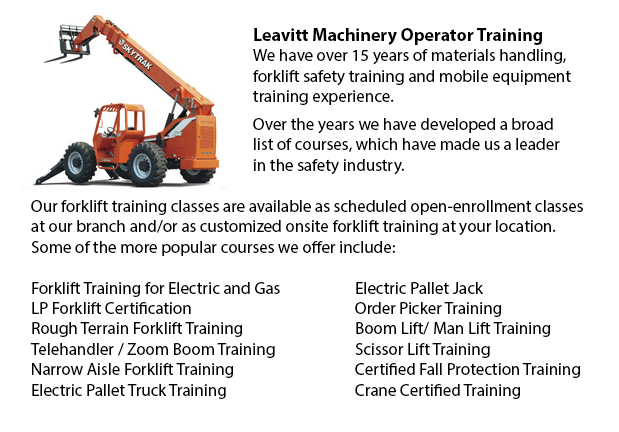
Saskatoon Zoom Boom Training - Zoom Boom Training is designed to train operators on variable reach forklifts. The goals of the training are to be able to impart an understanding of the physics of the machinery, and to outline the operator's responsibilities. This course follows North American safety standards for lift trucks. Zoom boom training and certification is obtainable at our site or at the company's location, provided there are a minimum number of trainees. Certification given upon successful completion is valid for three years.
A telescopic handler (otherwise called a telehandler) is similar in some ways to both a forklift and a crane. It is a helpful equipment constructed with a telescopic boom that could lift upwards and extend forward. Different attachments could be fitted on the end of the boom, such as pallet forks, bucket, muck grab or lift table. It is popular in industry and agriculture settings.
Telehandlers are most usually used along with the fork attachment to shuttle loads. The units have the advantage that they can get to places inaccessible to regular forklifts. Telehandlers could remove palletized loads from inside a trailer and putting them on places which are high like rooftops. For certain applications, they can be much more efficient and practical than a crane.
The disadvantage of the telehandler is its unsteadiness when lifting loads which are heavier. When the boom extends with a load, the unit becomes increasingly unsteady. Counterweights found at the back help, but do not solve the problem. The lifting capacity quickly decreases when the working radius increases. Various equipment come with front outriggers that extend the lifting capacity whilst the equipment is stationary.
A load chart helps the operator to determine whether a given load is exceedingly heavy. Factors such as load weight, boom angle and height are calculated. Several telehandlers have sensors which provide a warning or cut off further control if the unit is in danger of destabilizing.
-
Saskatoon Telehandler License
Saskatoon Telehandler License - The telescopic handler or telehandler is a frequently utilized machine in agricultural and industrial applications. This particular equipment is similar in appearance to a forklift and even functions in a similar way,... More -
Saskatoon Zoom Boom Ticket
Saskatoon Zoom Boom Ticket - Zoom Boom Training focuses on correctly training prospective operators on variable reach forklifts. The training objectives consist of gaining the knowledge of the machine's physics and to define the job of the operator.... More -
Saskatoon Forklift Operator Training
Saskatoon Forklift Operator Training - In North America, lift truck operator training is needed in order to prevent workplace injuries and accidents. Particular lift truck training will be provided to offer forklift operators driver training. The saf... More -
Saskatoon Forklift Certification Schools
Saskatoon Forklift Certification Schools - Forklift Certification is mandatory in North America. Hence, forklift training programs are essential both for businesses and for individuals seeking jobs in industries as forklift operators. Forklift traini... More -
Saskatoon Telehandler Training Courses
Saskatoon Telehandler Training Courses - Employers are responsible for making certain that their operating personnel and supervisors are trained to work competently utilizing telehandler machines. The competence level of staff must be assessed. If de... More -
Saskatoon Boom Lift Training
Saskatoon Boom Lift Training - Aerial platforms or likewise known as elevated work platforms are devices that enable workers to perform tasks and duties at elevated heights that will not be otherwise accessible. There are many aerial lifts available... More -
Crane / Overhead Crane / Self-Erect Crane / Truck Mounted Crane / Hydraulic Cranes Training in Saskatoon
Overhead cranes are likewise referred to as bridge cranes. They are a type of crane which comprises a line and hook device that runs along a horizontal beam which runs along two widely separated rails. Several overhead cranes can be found within a lo... More -
Saskatoon Heavy Equipment Training Programs
Saskatoon Heavy Equipment Training Programs - At any given construction site, there are usually different types of machinery which are ready to be used. These light and heavy machinery require both operators to run them and mechanics to fix them. Tra... More

Forklift Certification Saskatoon
TOLL FREE: 1-888-254-6157
Saskatoon, Saskatchewan
forkliftcertificationsaskatoon.com
Email Us
About Us


